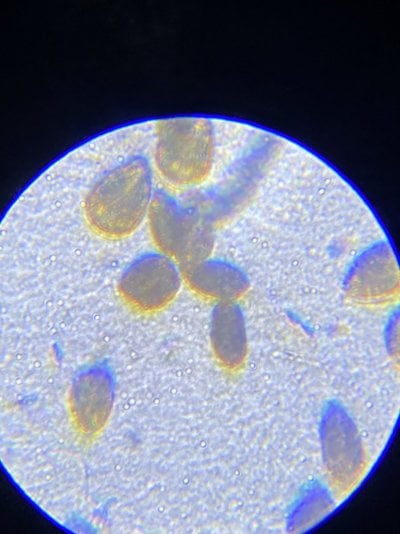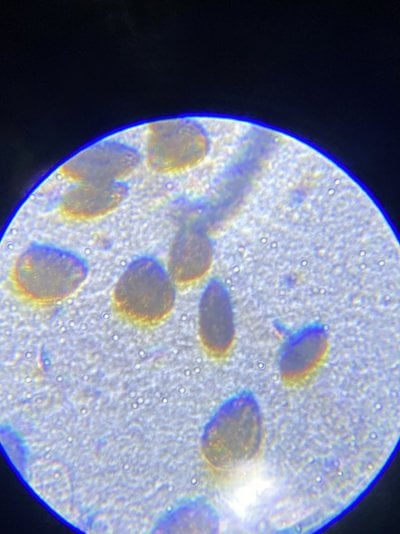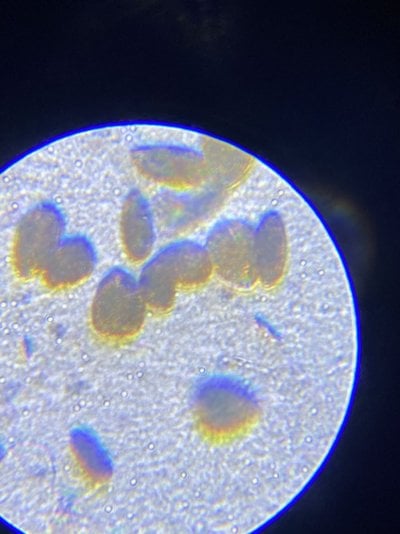- Joined
- Jul 18, 2019
- Messages
- 567
- Reaction score
- 538
Another note: forgot to mention it seems very toxic as all my cleanup crew died.
Follow along with the video below to see how to install our site as a web app on your home screen.
Note: This feature may not be available in some browsers.
Appears to be Amphidinium based on the curved beak, though I could be wrong. I posted about how I battled them on the previous page, but I forgot to add a few other pieces of info.Could someone with the knowledge ID these please?

Yours appears to be ostreopsis (though again could be wrong). UV works extremely well on this type. How many gallons is your tank? You want around 1 watt per 3 gallons for UV. If you have a local club see if someone will loan you one, or if it is a smaller tank you can buy lower wattage ones fairly cheap.Another note: forgot to mention it seems very toxic as all my cleanup crew died.
Could someone with the knowledge ID these please?

Thanks for the feedback. What about using dinox ?Appears to be Amphidinium based on the curved beak, though I could be wrong. I posted about how I battled them on the previous page, but I forgot to add a few other pieces of info.
What I did for Amphidinium:
-Immediately raised nitrate and phosphates as they bottomed out. This took time to remain detectable, many times after I thought I had dosed enough to get high readings it would show zero for both. Once detectable I kept them there. Didn't test phosphate hardly but nitrate held around 15 (some would say this is too high I had no issues)
-Turned off skimmer
-Added 40w UV filter to display
-3 day black out with aquarium panes fully wrapped with opened up boxes and random crap I had
-Added tiger conch from LFS which ate the dinos on sand with no ill effects
-Dose 1 ml per 10 gallon tank volume of hydrogen peroxide in morning and night; 12 hr intervals
-At start of day 3 of blackout, I did a minimum dose of Dr. Tim's waste away. No idea whether this helped or not but had some already and dosed it
-Once 3 day black out was done, I ran my AI Hydras very low with NO whites. Started around 20% V, RB, B, UV, and 5 G and 5 R for algae. I ramped up blues by 20% every 5 days until normal AB+ levels
-Began spongexcel dosing (silica) at minimum dose for a week after blackout ended. Never got a diatom bloom, just light glass dusting
-Feeding algaebarn phyto daily and still do this.
20 gallons! I just hooked up a 9w UV sterilizer and will continue on the blackout and peroxide dosing and got some mb7 to dose as well. Thanks!Yours appears to be ostreopsis (though again could be wrong). UV works extremely well on this type. How many gallons is your tank? You want around 1 watt per 3 gallons for UV. If you have a local club see if someone will loan you one, or if it is a smaller tank you can buy lower wattage ones fairly cheap.
Sorry but I only see specks that are not definitive for anything. Hopefully there are better eyes out there. At 400X I can help.ID on dinos sorry for bad pics the microscope doesn’t zoom farther in. Looks more like dust on the rocks and sand and terrible on the glass...sometimes snot looking but never any air bubbles. On microscope it’s rounded with a divot where the “mouth” area is. Moves fast and spins in a spiral super fast rather than anchored at one spot. Not sure if the videos work or how I should upload them on my phone! Thanks!
note: am doing a 3 day blackout with peroxide dosing and UV sterilizer. Started yesterday as I had been treating this CONVINCED it was diatoms..haha
Please tell me what is in it and how it works. You would be the first to do so. (sorry for the passive/aggressive tone but snake oil bugs me.Thanks for the feedback. What about using dinox ?
Yep the microscope only had 40x lol was using one at work...maybe I need to buy oneSorry but I only see specks that are not definitive for anything. Hopefully there are better eyes out there. At 400X I can help.
Please tell me what is in it and how it works. You would be the first to do so. (sorry for the passive/aggressive tone but snake oil bugs me.
Experience here (short term) is very mixed. Longer term is unknown.
I would FIRST determine your species before deciding on treatment protocol. Some are very easy to manage. If you have large cell amphids things are different.
From the feedback I've gotten from people online I'm told it is large cell amphids.Sorry but I only see specks that are not definitive for anything. Hopefully there are better eyes out there. At 400X I can help.
Please tell me what is in it and how it works. You would be the first to do so. (sorry for the passive/aggressive tone but snake oil bugs me.
Experience here (short term) is very mixed. Longer term is unknown.
I would FIRST determine your species before deciding on treatment protocol. Some are very easy to manage. If you have large cell amphids things are different.
I would just save time and dose liquid phosphate and nitrate. Feeding alone wasn't enough to make any increase for me.From the feedback I've gotten from people online I'm told it is large cell amphids.
The plan is to try DinoX now and also up my feeding to raise Phos and Nitrates. Might have to dose liquid phos if that doesnt work.
A 250ml bottle is only 20 euro, so the expense is low. My lfs has said its safe to use, hes given good advice up until now.I would just save time and dose liquid phosphate and nitrate. Feeding alone wasn't enough to make any increase for me.
Also haven't seen enough good experiences with DinoX to make it worth the expense. For every success I've come across, there's 10 others that reported no impact or it killed livestock.
I used brightwell's neophos, and i think they have a nitrate tooA 250ml bottle is only 20 euro, so the expense is low. My lfs has said its safe to use, hes given good advice up until now.
I was thinking of turning the skimmer off, or maybe for 8hrs a day. Any view on doing that?
also, any liquid phos or nitrate brands to recommend?
thanks
I like the gas exchange a skimmer provides. You could just let the collection cup drain back into the sump.A 250ml bottle is only 20 euro, so the expense is low. My lfs has said its safe to use, hes given good advice up until now.
I was thinking of turning the skimmer off, or maybe for 8hrs a day. Any view on doing that?
also, any liquid phos or nitrate brands to recommend?
thanks
I hadn't noticed any obvious signs of dinos since putting the supplemental UV back in the tank earlier this week...until today. This morning I fed Reef Chili for my picky Pink Streak. The sample in the video above was taken from my gorgonian this evening. Could this particular food really be my trigger? Would the dinos react this fast?
Small aside - it sucks that these things are so problematic because the view in the microscope is truly fascinating. I watched a bizarre interaction between what appeared to be a dino and a diatom. They both eventually went their own way but it almost looked like one was trying to unsuccessfully consume the other. I'm blown away by the amount of life I found in two drops of water with just a toy microscope.




Hello everyone, just wanting to confirm what I'm battling and the best way to battle.
Nutrients have never been a problem for me, so I knew that wasn't the cause.
RODI with Chloramine Monster - 7 TDS into Resin/0 TDS out
Tropic Marin Pro Salt - Would water change every 2 weeks prior to outbreak
Tank is a bare bottom peninsula 150g display 180g total - entirely SPS
Fish = 2 Clowns, 1 Naso Tang, 1 Fox Face, 1 Yellow Tang, 1 CBB, 2 Sunset Anthias, 1 Spotted Mandarin, 1 Royal Gramma, 1 Helfrichi Firefish (Missing/Dead?), and a "Midas Blenny" that never became Midas.
Lighting is Radion G5 Blue's at 56% - 10 hours a day
Filtration - Reef Octo 200 INT Regal Skimmer, GAC, and Clearwater Turf Scrubber
NO3 - 25
PO4 - 0.08
Sg - 1.025
Tmp - 77.6-78.8
Ph - 8.08 - 8.39
Alk - 9.0
Ca - 470
Mg - 1420
@taricha
Ostreopsis dinos. That's both good news and bad news. The good news is they are the easiest and the fastest to get rid of. A properly sized and plumbed UV will make inroads on them literally over night. The bad news is they are the most toxic strain and corals suffer from them terribly as do inverts. The other bad news is that if you don't change the factors that caused them to begin with they could come back when you remove the UV.
Any changes to the tank recently or thoughts on what might have provoked them? Your nutrient levels are not low which is the most common trigger. Recently treat other nuisance algae with anything?
Removed a very mean Purple Tang and installed the turf scrubber
My theory, when installing the ATS, I didn't wait the customary 30+mins for the primer and glue to fully dry. I suspect that some residual toxin entered the system. I observed ALL of my digi's were very angry for a day. My theory, I nuked a good portion of my bacterial army that existed on the surfaces.LOL, I don't think we can blame the tang (I had to do the same with mine). Did the turf scrubber make any large/sudden changes in your nutrients? Is you PO4 stable at 0.08?
Oh and because of their toxicity it's wise to run quality GAC (carbon) and change it often when they are present or being treated.

